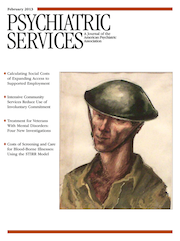Characteristics of Frequent Users of an Acute Psychiatric Inpatient Unit: A Five-Year Study in Portugal
Abstract
Objective
This study examined demographic and clinical characteristics of frequent users of a psychiatric inpatient unit in Portugal.
Methods
Data (2004–2008) for 1,348 consecutive psychiatric inpatients were reviewed. Frequent users (N=137), who had at least three admissions in the study period, were compared with nonfrequent users (N=1,211) on age, gender, race-ethnicity, diagnosis, and compulsory admissions. Data were analyzed with chi square and Student’s t tests.
Results
Frequent users accounted for 29% of admissions. They were significantly younger than nonfrequent users (39±14 versus 44±17, p<.001), and a larger proportion had compulsory admissions (28% versus 14%, p<.001). The frequent user group also had significantly higher rates of bipolar disorder (61% versus 46%, p<.001) and schizophrenia (29% versus 18%, p<.003).
Conclusions
Understanding characteristics of frequent users can inform development of appropriate services. Research should address other variables related to frequent admissions, including socioeconomic factors, general medical and psychiatric comorbidities, and treatment compliance.



